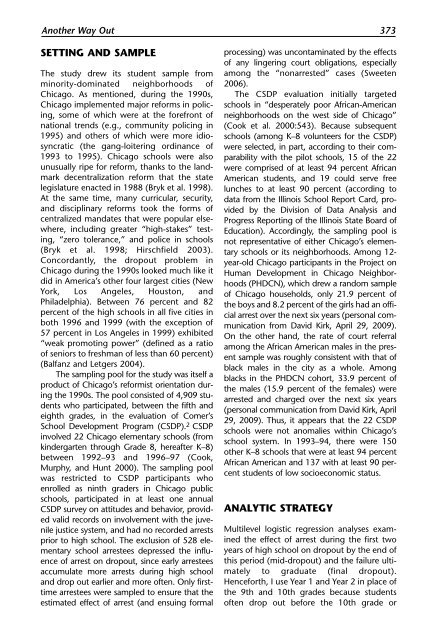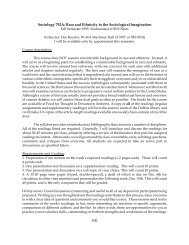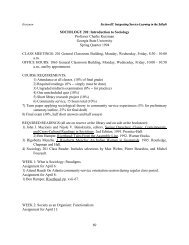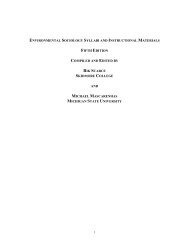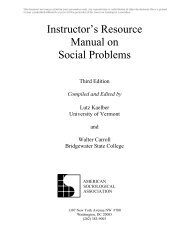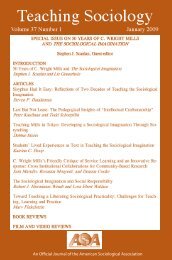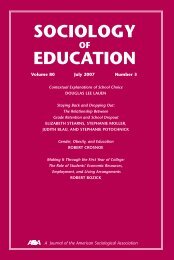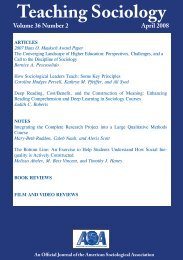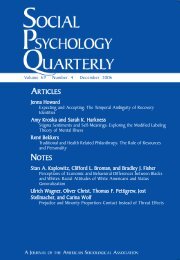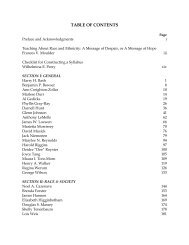SOCIOLOGY EDUCATION - American Sociological Association
SOCIOLOGY EDUCATION - American Sociological Association
SOCIOLOGY EDUCATION - American Sociological Association
You also want an ePaper? Increase the reach of your titles
YUMPU automatically turns print PDFs into web optimized ePapers that Google loves.
Another Way Out 373<br />
SETTING AND SAMPLE<br />
The study drew its student sample from<br />
minority-dominated neighborhoods of<br />
Chicago. As mentioned, during the 1990s,<br />
Chicago implemented major reforms in policing,<br />
some of which were at the forefront of<br />
national trends (e.g., community policing in<br />
1995) and others of which were more idiosyncratic<br />
(the gang-loitering ordinance of<br />
1993 to 1995). Chicago schools were also<br />
unusually ripe for reform, thanks to the landmark<br />
decentralization reform that the state<br />
legislature enacted in 1988 (Bryk et al. 1998).<br />
At the same time, many curricular, security,<br />
and disciplinary reforms took the forms of<br />
centralized mandates that were popular elsewhere,<br />
including greater “high-stakes” testing,<br />
“zero tolerance,” and police in schools<br />
(Bryk et al. 1998; Hirschfield 2003).<br />
Concordantly, the dropout problem in<br />
Chicago during the 1990s looked much like it<br />
did in America’s other four largest cities (New<br />
York, Los Angeles, Houston, and<br />
Philadelphia). Between 76 percent and 82<br />
percent of the high schools in all five cities in<br />
both 1996 and 1999 (with the exception of<br />
57 percent in Los Angeles in 1999) exhibited<br />
“weak promoting power” (defined as a ratio<br />
of seniors to freshman of less than 60 percent)<br />
(Balfanz and Letgers 2004).<br />
The sampling pool for the study was itself a<br />
product of Chicago’s reformist orientation during<br />
the 1990s. The pool consisted of 4,909 students<br />
who participated, between the fifth and<br />
eighth grades, in the evaluation of Comer’s<br />
School Development Program (CSDP). 2 CSDP<br />
involved 22 Chicago elementary schools (from<br />
kindergarten through Grade 8, hereafter K–8)<br />
between 1992–93 and 1996–97 (Cook,<br />
Murphy, and Hunt 2000). The sampling pool<br />
was restricted to CSDP participants who<br />
enrolled as ninth graders in Chicago public<br />
schools, participated in at least one annual<br />
CSDP survey on attitudes and behavior, provided<br />
valid records on involvement with the juvenile<br />
justice system, and had no recorded arrests<br />
prior to high school. The exclusion of 528 elementary<br />
school arrestees depressed the influence<br />
of arrest on dropout, since early arrestees<br />
accumulate more arrests during high school<br />
and drop out earlier and more often. Only firsttime<br />
arrestees were sampled to ensure that the<br />
estimated effect of arrest (and ensuing formal<br />
processing) was uncontaminated by the effects<br />
of any lingering court obligations, especially<br />
among the “nonarrested” cases (Sweeten<br />
2006).<br />
The CSDP evaluation initially targeted<br />
schools in “desperately poor African-<strong>American</strong><br />
neighborhoods on the west side of Chicago”<br />
(Cook et al. 2000:543). Because subsequent<br />
schools (among K–8 volunteers for the CSDP)<br />
were selected, in part, according to their comparability<br />
with the pilot schools, 15 of the 22<br />
were comprised of at least 94 percent African<br />
<strong>American</strong> students, and 19 could serve free<br />
lunches to at least 90 percent (according to<br />
data from the Illinois School Report Card, provided<br />
by the Division of Data Analysis and<br />
Progress Reporting of the Illinois State Board of<br />
Education). Accordingly, the sampling pool is<br />
not representative of either Chicago’s elementary<br />
schools or its neighborhoods. Among 12year-old<br />
Chicago participants in the Project on<br />
Human Development in Chicago Neighborhoods<br />
(PHDCN), which drew a random sample<br />
of Chicago households, only 21.9 percent of<br />
the boys and 8.2 percent of the girls had an official<br />
arrest over the next six years (personal communication<br />
from David Kirk, April 29, 2009).<br />
On the other hand, the rate of court referral<br />
among the African <strong>American</strong> males in the present<br />
sample was roughly consistent with that of<br />
black males in the city as a whole. Among<br />
blacks in the PHDCN cohort, 33.9 percent of<br />
the males (15.9 percent of the females) were<br />
arrested and charged over the next six years<br />
(personal communication from David Kirk, April<br />
29, 2009). Thus, it appears that the 22 CSDP<br />
schools were not anomalies within Chicago’s<br />
school system. In 1993–94, there were 150<br />
other K–8 schools that were at least 94 percent<br />
African <strong>American</strong> and 137 with at least 90 percent<br />
students of low socioeconomic status.<br />
ANALYTIC STRATEGY<br />
Multilevel logistic regression analyses examined<br />
the effect of arrest during the first two<br />
years of high school on dropout by the end of<br />
this period (mid-dropout) and the failure ultimately<br />
to graduate (final dropout).<br />
Henceforth, I use Year 1 and Year 2 in place of<br />
the 9th and 10th grades because students<br />
often drop out before the 10th grade or


